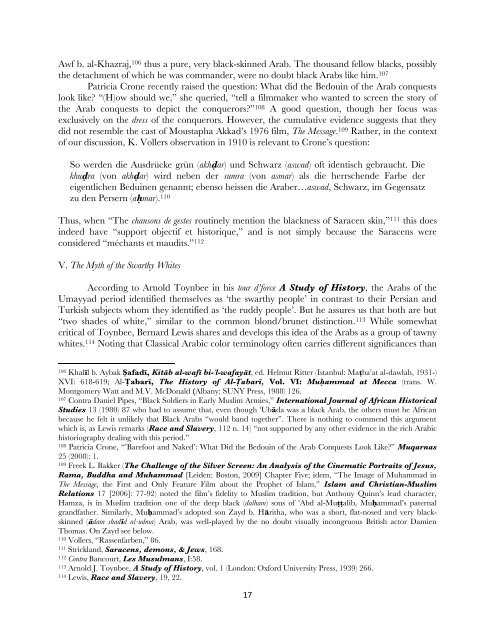Muhammad_Article.349.. - Dr. Wesley Muhammad
Muhammad_Article.349.. - Dr. Wesley Muhammad
Muhammad_Article.349.. - Dr. Wesley Muhammad
Create successful ePaper yourself
Turn your PDF publications into a flip-book with our unique Google optimized e-Paper software.
Awf b. al-Khazraj, 106 thus a pure, very black-skinned Arab. The thousand fellow blacks, possibly<br />
the detachment of which he was commander, were no doubt black Arabs like him. 107<br />
Patricia Crone recently raised the question: What did the Bedouin of the Arab conquests<br />
look like? “(H)ow should we,” she queried, “tell a filmmaker who wanted to screen the story of<br />
the Arab conquests to depict the conquerors?” 108 A good question, though her focus was<br />
exclusively on the dress of the conquerors. However, the cumulative evidence suggests that they<br />
did not resemble the cast of Moustapha Akkad’s 1976 film, The Message. 109 Rather, in the context<br />
of our discussion, K. Vollers observation in 1910 is relevant to Crone’s question:<br />
So werden die Ausdrücke grün (akh∙ar) und Schwarz (aswad) oft identisch gebraucht. Die<br />
khu∙ra (von akh∙ar) wird neben der sumra (von asmar) als die herrschende Farbe der<br />
eigentlichen Beduinen genannt; ebenso heissen die Araber…aswad, Schwarz, im Gegensatz<br />
zu den Persern (aÈmar). 110<br />
Thus, when “The chansons de gestes routinely mention the blackness of Saracen skin,” 111 this does<br />
indeed have “support objectif et historique,” and is not simply because the Saracens were<br />
considered “méchants et maudits.” 112<br />
V. The Myth of the Swarthy Whites<br />
According to Arnold Toynbee in his tour d’force A Study of History, the Arabs of the<br />
Umayyad period identified themselves as ‘the swarthy people’ in contrast to their Persian and<br />
Turkish subjects whom they identified as ‘the ruddy people’. But he assures us that both are but<br />
“two shades of white,” similar to the common blond/brunet distinction. 113 While somewhat<br />
critical of Toynbee, Bernard Lewis shares and develops this idea of the Arabs as a group of tawny<br />
whites. 114 Noting that Classical Arabic color terminology often carries different significances than<br />
106 KhalÊl b. Aybak ‘afadÊ, Kit§b al-wafÊ bi-"l-wafay§t, ed. Helmut Ritter (Istanbul: Maãba#at al-dawlah, 1931-)<br />
XVI: 618-619; Al-•abarÊ, The History of Al-•abarÊ, Vol. VI: MuÈammad at Mecca (trans. W.<br />
Montgomery Watt and M.V. McDonald (Albany: SUNY Press, 1988) 126.<br />
107 Contra Daniel Pipes, “Black Soldiers in Early Muslim Armies,” International Journal of African Historical<br />
Studies 13 (1980) 87 who had to assume that, even though #Ub§da was a black Arab, the others must be African<br />
because he felt it unlikely that Black Arabs “would band together”. There is nothing to commend this argument<br />
which is, as Lewis remarks (Race and Slavery, 112 n. 14) “not supported by any other evidence in the rich Arabic<br />
historiography dealing with this period.”<br />
108 Patricia Crone, “’Barefoot and Naked’: What Did the Bedouin of the Arab Conquests Look Like?” Muqarnas<br />
25 (2008): 1.<br />
109 Freek L. Bakker (The Challenge of the Silver Screen: An Analysis of the Cinematic Portraits of Jesus,<br />
Rama, Buddha and <strong>Muhammad</strong> [Leiden: Boston, 2009] Chapter Five; idem, “The Image of <strong>Muhammad</strong> in<br />
The Message, the First and Only Feature Film about the Prophet of Islam,” Islam and Christian-Muslim<br />
Relations 17 [2006]: 77-92) noted the film’s fidelity to Muslim tradition, but Anthony Quinn’s lead character,<br />
Hamza, is in Muslim tradition one of the deep black (dalham) sons of #Abd al-Muããalib, MuÈammad’s paternal<br />
grandfather. Similarly, MuÈammad’s adopted son Zayd b. H§ritha, who was a short, flat-nosed and very blackskinned<br />
(§dam shadÊd al-udma) Arab, was well-played by the no doubt visually incongruous British actor Damien<br />
Thomas. On Zayd see below.<br />
110 Vollers, “Rassenfarben,” 86.<br />
111 Strickland, Saracens, demons, & Jews, 168.<br />
112 Contra Bancourt, Les Musulmans, I:58.<br />
113 Arnold J. Toynbee, A Study of History, vol. 1 (London: Oxford University Press, 1939) 266.<br />
114 Lewis, Race and Slavery, 19, 22.<br />
17

















